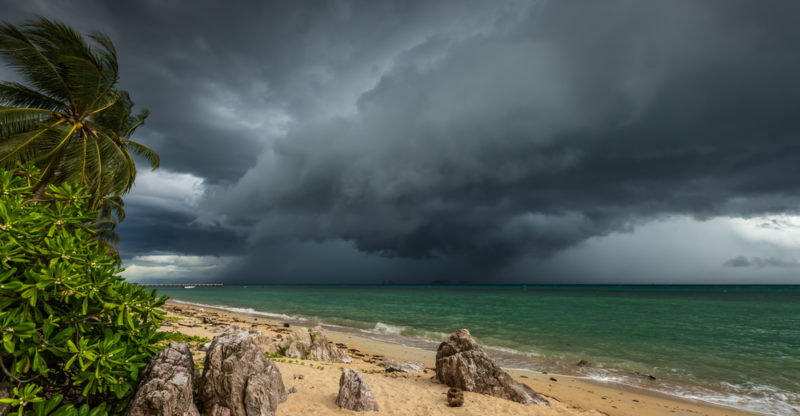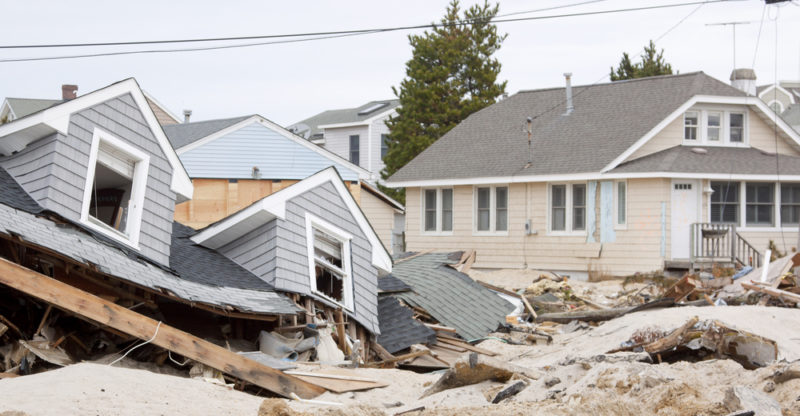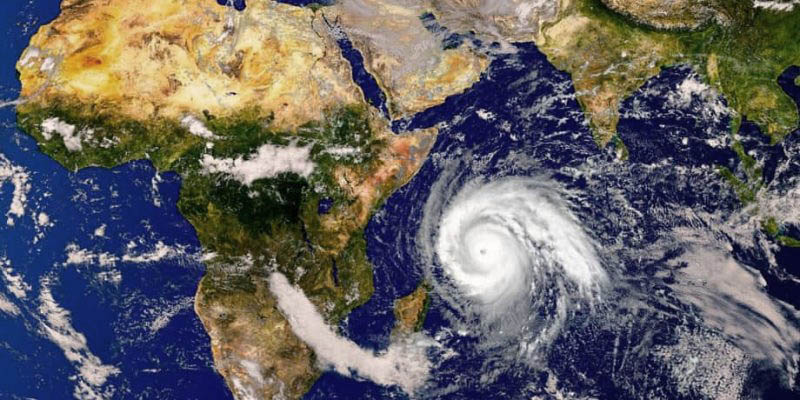We explore tropical storms, and explain how they are formed. In addition, we discuss their characteristics, effects, and types.

What is a tropical storm?
A tropical storm is a low-pressure weather system with winds rotating around a center in a closed circulation.
Tropical storms are characterized by torrential rain and strong winds, whose intensity and destructiveness vary mainly according to the water temperature and air humidity in the area where the storm develops.
Depending on the intensity, they are tropical depressions (low intensity), tropical storms (medium intensity), and hurricanes or typhoons (high intensity). Some of these storms can be so large that they are visible from the planet's outer atmosphere.
Cyclone or tropical storm? The terms cyclone and tropical storm should not be confused. A cyclone is a weather system with a low-pressure center and rotating winds. Cyclones may be small or very large, and can form in different parts of the world. A tropical storm is a specific type of tropical cyclone, with strong winds that are higher than those of a tropical depression but not as high as those of a hurricane or typhoon.
- See also: Sandstorm
Types of cyclones
Various types of tropical cyclones can be identified, which are classified based on their location and the intensity of the winds:
- Tropical depression. This is the type of cyclone that presents the lowest wind intensity, not exceeding 40 miles (65 km) per hour. Although they can produce heavy rain and moderate winds, they usually do not cause significant property damage.
- Tropical storm. It forms when the sustained winds of a tropical cyclone reach between 40 and 75 miles (65 and 120 km) per hour. It is characterized by the presence of an "eye", an area of relative atmospheric calm located at the center of the storm, which is surrounded by clouds and rain.
- Hurricane. It is a very intense tropical cyclone that forms when winds are higher than 75 miles (120 km) per hour. Its extensive storm areas can exceed 621 miles (1,000 km) in diameter and cause significant property damage and loss of human lives. The Saffir-Simpson scale classifies them into five categories, from 1 to 5, with category 5 being the most destructive.
- Typhoon. It has the same characteristics as a hurricane but differs in the geographical location where it develops. While hurricanes are tropical storms that form in the Atlantic Ocean, mainly in the Caribbean region, typhoons develop in the Pacific Ocean, on the coasts of Asia.
In addition to tropical cyclones, there are other types depending on the latitude where cyclones occur:
- Extratropical cyclones. They form at latitudes above 30°, outside tropical zones.
- Subtropical cyclones. They form in subtropical areas and are usually less intense than extratropical cyclones.
- Polar cyclones. They form in polar regions and can cause snowstorms.
How do tropical storms form?

Tropical storms form over the ocean surface from the combination of three factors:
- An area of low pressure and high temperature in the atmosphere, as tropical storms need warm air to form.
- High temperatures in ocean waters, as tropical storms form over warm waters.
- High humidity in the atmosphere, necessary for the formation of clouds and rain.
When these three factors combine, warm, humid air rises from the sea surface. As it gains altitude, it cools, condenses its water vapor particles, and forms clouds. As the storm continues to develop, the clouds grow larger, and more warm and humid air accumulates, forming a tropical storm.
This circuit is repeated as the storm gains strength and moves over the ocean, producing heavy rainfall and storms.
When the storm reaches the continent and no longer has the ocean's moisture to feed on, it usually loses intensity and eventually dissipates.
In tropical regions, high temperatures and humidity are common climatic elements, especially in the spring and summer months when there is more solar radiation and the temperature is warmer. For this reason, although tropical storms can form at any time of the year, they are more frequent during warm months.
Effects of tropical storms

Tropical storms can cause enormous damage, even when they do not turn into hurricanes.
The greatest damage typically occurs in coastal areas, since these storms lose intensity and strength as they move inland. In areas near the sea, strong winds and rainfall may cause objects to blow away, demolish homes, and lead to flooding.
The arrival of these types of storms can have serious consequences for both the population and urban infrastructure. The recovery of areas affected by a tropical storm may take weeks, months, or even years.
The rebuilding of damaged infrastructure, debris removal, and the relief of people affected by the storm often requires a great deal of resources and time.
When do tropical storms most likely occur?
The highest occurrence of tropical storms worldwide occurs towards the end of summer, when seas are warmer.
Although each region may have its own conditions and storm seasons, it has been observed that February is usually the least active month, with September being the most active month globally.
Typical areas of tropical storm formation

The regions where tropical storms develop are to be found in the planet’s major oceans:
- North Atlantic. It includes the coast of North America, the Caribbean Sea, and the Gulf of Mexico.
- North Pacific. It includes the Bering Sea, the Sea of Japan, and the Yellow Sea.
- Southwest Pacific. It covers the coasts of Australia, Indonesia, and the Philippines.
- North Indian Ocean. It covers the Bay of Bengal, and the Arabian Sea.
- South Indian Ocean. It affects the coasts of Africa, Western Australia, and Antarctica. The occurrence of tropical storms in these regions is very rare.
How do tropical storms get their name?
Since 1950, tropical storms have been identified with personal names. Initially, they were given female names, but starting in 1970, male names have also been used.
The names are chosen in alphabetical order. Thus, the name of the first storm will receive a name starting with the letter A, the second with B, and so on with subsequent storms.
This also serves to identify the number of storms that occurred in a given season. For example, if the storm is named "Iris", it means it is the ninth tropical storm since the count began that year.
References
- National Geographic (2022). ¿Qué es un huracán? NationalGeographicLA
- Organización Meteorológica Mundial (OMM) (s.f). Ciclones tropicales. WMO
- Organización Panamericana de la Salud (OPS) (s.f). Tormentas. PAHO
- Arriols, E. (2018). ¿Qué es un tifón y cómo se forma? Ecología Verde. EcologiaVerde
Explore next:
Was this information useful to you?
Yes NoThank you for visiting us :)